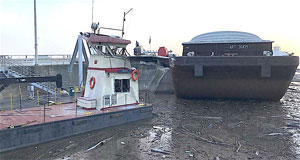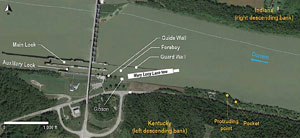Mary Lucy Lane looked out of shape as its 12-barge tow neared Markland Locks and Dam on the Ohio River in Warsaw, Ky. A challenging crosscurrent from the dam sucked the downbound vessels farther out of position during their final approach.
Mary Lucy Lane’s pilot steered the vessels away from the dam gates, but the starboard barge string bumped against the locks’ guard wall. Moments later, the lead barge in the center string ran head-on into the front of the guide wall running along the riverbank. The port-side barge string broke away on impact, and its lead barge struck an unmanned U.S. Army Corps of Engineers workboat.
The incident happened at about 1540 on Dec. 18, 2018, at mile marker 531.5 when the river level was high and still rising. No injuries were reported among Mary Lucy Lane’s eight crewmembers, and there was no pollution. Damage to the locks and barges totaled nearly $322,000. Replacing Gibson, the Army Corps’ 40-foot workboat, cost $1.8 million.
National Transportation Safety Board (NTSB) investigators attributed the incident to “a strong outdraft above the dam caused by the extreme high flow conditions, which overwhelmed the pilot’s ability to control the Mary Lucy Lane tow before locking.” The agency described an outdraft as “a river crosscurrent that pulls toward a downstream dam in front of upstream lock gates and guard walls.”
One day after the incident, the first tow to pass through the reopened downbound lock had a nearly identical casualty. Mary Lucy Lane and Jack James, the towboat involved in the second casualty, both tied up at the same mooring cells about a mile upriver. The Coast Guard closed these cells for three months following the two incidents, and authorities later suggested downbound tows not use them when dam gates are at least one-quarter open.
The 140-foot, 7,600-hp Mary Lucy Lane, owned by Canal Barge Co. of New Orleans, was downbound with a final destination of Cairo, Ill. It was guiding 12 barges arranged in three strings of four barges each as it approached Markland at about 0930 on Dec. 18. The vessels got underway from the federal mooring cells at 1526 after receiving permission to pass through the locks.
The river level was rising as the tow approached the locks. The dam’s 12 gates were open a combined 177 feet out of a possible 480 feet. The approach to the locks can be tricky even in calmer conditions due to a small point just upstream that makes for a narrower opening.
 |
|
The damaged Gibson had to be replaced at a cost of $1.8 million. |
|
U.S. Coast Guard photo |
“When this area experienced high-water conditions, there were two known hazards, including stronger outdraft as water rose and the current became stronger, and the potential to strike and/or wrap around the pocket and protruding point at mile 531 on the left descending bank, thereby increasing the potential for vessel contact with Markland L&D,” the NTSB said in its report.
The lock master noticed the vessels appeared out of shape as they approached Markland, enough so that he activated a security camera system to capture the approach.
“At 1534, the aft end of the tow was drawn toward the guard wall due to what the pilot described as ‘crosscurrent’ (outdraft),” the NTSB said. “Video footage showed that at (1540), Mary Lucy Lane was no longer lined up on the inside of the guard wall.”
The starboard barge string made contact with the guard wall’s protective bullnose at 1542 between the second and third barges, causing the facing and wing wires to break. WCAO 116, the lead barge in the center string, hit the protective bullnose on the riverside guide wall, dislodging a massive section of concrete. Twelve seconds later, port-side lead barge ART 36109 hit the workboat Gibson.
Authorities established a safety zone around the locks and dam on Dec. 20 following the Jack James incident, an event for which there are few details. Downbound tows passing through the locks could do so only during daylight hours, with an assist vessel standing by. They also were barred from using the mooring cells just upriver, a policy that remained in place until March 2019 when river levels subsided.
The incidents also spurred changes to the Waterways Action Plan for the Markland facility, particularly the suggestion not to use the upstream mooring cells in question when the dam opening is 120 feet or more. The Coast Guard and Army Corps, according to the NTSB report, both recognized the mooring cells made a challenging approach more difficult.
“(The) 0.9-mile distance from the mooring cells to the dam does not give a moored tow sufficient distance to gain speed and make an approach for southbound locking operations during extreme high water/high flow conditions,” the report said. “Tows moored to the cells would also obstruct the approach of a southbound tow conducting locking operations by forcing the tow toward the middle of the river until clear of moored tows.”
In a prepared statement, Canal Barge said it agree with the NTSB’s conclusions.
“Understanding the root cause and any secondary cause of the allision is important to our company, our people, our federal partners and our industry as a whole,” said Spencer Murphy, general counsel and vice president of risk management for Canal Barge. “We appreciate NTSB’s engagement with us in this investigation and accept their findings as an important step toward continuous safety improvement, especially in high-water conditions.”

